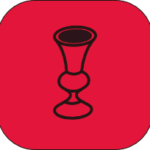
Our core values include trust, respect, commitment, kindness, charity and support. We live and breathe these values in all of our activities and encourage all members to do the same.
Members share the same beliefs, principles and moral values and this encourages them to support each other and those less fortunate. All members share a common belief in the existence of a ‘supreme being’. The Order is non-denominational and non-sectarian but the principles and values shared by members, are based on stories from the Old and New Testament, and are designed to make a profound and lasting impression upon all to whom they are addressed.
The centre piece in every Chapter Room is an Altar. When the Chapter is in session, an open Bible rests on top. The Bible is open at Chapter 2 in the Book of Matthew in the Christian Bible. This Chapter relates the story of the first Christmas and the 3 wise men who travelled to meet and worship the baby Jesus. In that narrative, the wise men followed a bright star in the sky to help them find the birthplace of the baby Jesus. That bright star is called the Eastern Star, and represents the inspiration for the name of our Order.
The Altar rests in the middle of a 5 Pointed Star. Each Point of the Star has a story, a colour, and a special meaning for all members. Emblematic Symbols for each Point remind members of that story and what values they should aspire to in their lives.
 Adah
AdahAdah is the first Point in the Star. Its colour is blue and its message is of Loyalty and Commitment. The story is of a man called Jephthah and his only child, his daughter. Jephthah was a Jewish ruler and had to go off to war to fight those who would see the Jewish race destroyed. Before he left, he prayed to his God and asked that he be victorious. He made a promise to his God that if he was victorious, he would offer up to the Lord the first thing that came to meet him on his return. Jephthah carried his sword into battle, he was victorious, but on his return, the first thing that came to meet him was his only child, his daughter. As you can imagine, Jephthah was distraught when he remembered the promise he had made to his God. He told his daughter of his promise, but her immediate reaction came through her loyalty to her Father and what he believed in. She told him that he should keep the vow he made, but asked that she be allowed to go away for 2 months to prepare herself, then she would return so that he could carry out his promise.
Jephthah kept his commitment to his God. The emblem of Adah is the Sword and Veil – the sword represents the concept that it may sometimes be taken up in the defence of right and in the performance of duty. The veil is symbolic of revelation, and also of modesty and fearlessness.
The story also reminds us of the loyalty and commitment we should have to our family and friends, and what they believe in. There is danger in making promises – commitments – that are hard to keep. We should all be mindful of what we agree to do, as the promises we make should be considered a binding commitment.
Adah represents the proper respect you should have to any obligation and its binding force. The story that reminds members of this virtue is the story of Jephthah, a judge of Israel, who vowed to sacrifice to God the first thing to come out of his house to greet him upon his return in exchange for victory over the Ammonites. He was victorious and upon returning home, was met by his only child Adah. He carried out his promise to God although distraught and with good reason not to.
 Ruth
RuthRuth is the second Point of the Star. Its colour is yellow and its message is Devotion to our family and our friends. The story is of Naomi and her daughter-in-law Ruth. Ruth gave up her life, her people and her God to care for the ageing Naomi. The words “Whether though goest, I shall go. Whether though lodgest, I will lodge. Thy people will be my people, and Thy God, my God” were spoken by Ruth to Naomi, when Naomi wanted Ruth to leave her and return to her people. Ruth was devoted to Naomi’s welfare regardless of what the consequences of what that meant to herself.
In addition to reminding us of the importance of devotion to others, the emblem of this Point is a sheaf of wheat. Ruth gathered grain from the fields to sustain herself and Naomi. The sheaf also reminds us that we should go through life gathering here a little, and there a little, in order to prepare for our ageing years.
 Esther
EstherEsther is the third Point of the Star. Its colour is white and its message is of Duty and Responsibility. It is the story of a Jewish woman, Esther, who became the Queen of Persia, but kept secret the fact that she was of Jewish descent. It was her responsibility as Queen, to serve the King even though he was not aware of her heritage. One day, Queen Esther heard that enemies of the Jews had convinced the King to issue a Royal edict to destroy the Hebrew Race. Even though she had duties to uphold as the Queen of Persia, she could not stand by and let her own people die.
The emblem of Esther is a united crown and sceptre. Our duties and responsibilities will sometimes ask us to make sacrifices for others. We should do this, by remembering to be faithful to our obligations, and in doing that, we will have courage towards fighting for what is right.
 Martha
MarthaThe fourth Point of the Star is called Martha. Its colour is green and its message is about Faith and Hope. It is the story of Martha, her family and her meeting with Jesus. Martha’s brother Lazarus had taken ill and died. Martha, having faith in Jesus, sought him out in order to ask that he would bring Lazarus back from the dead. Her faith gave her hope. Hope makes us strive and reach for something higher. It doesn’t mean that what we strive for, will always be successful, but Hope lets us start again.
The emblem of this Point is a broken column. This reminds us that human life can be cut short and at any time. With faith and hope, we can remain optimistic and confident in times of distress and despair. It doesn’t matter what faith you have, as long as you have it. With hope and faith comes the confidence and courage that are needed to get through the trials of life.
 Electa
ElectaThe fifth and final Point of the Star is Electa. Its colour is red and its message is of Love, Charity and Hospitality. The story is not about 1 person, but the many women in history who have been persecuted for what they believe in. In Biblical times, this persecution came because these women had chosen to follow a particular religion and God. They were often asked to denounce their faith, and sometimes with the threat of death, but that made them stronger and they continued to care for those around them who needed food, shelter or simply a helping hand.
The emblem of Electa is a cup of charity. We must be brave and true to what we believe in. We must devote ourselves to giving to those in poverty or distress and regardless of any persecution we may receive. We should always hold out the cup of charity, and we should always, Love one another.
For more details about our Order, you can read THIS